Grand Organ, Exhibition Building, Melbourne, 1880
4 manuals, 70 speaking stops, barker lever action
Destroyed 1948/1965

Fincham's magnum opus, the instrument incorporated a 32ft facade and detached terraced console
Carlton Advertiser and Hotham Chronicle of 16 April 1881, reprinted c.1900 by Geo. Fincham & Son as a pamphlet entitled ‘The Melbourne Exhibition Organ’:
"Now that the Exhibition is drawing to a close, we are of opinion that a full description of this colossal undertaking by a Colonial builder will not be uninteresting, more especially as it will be found that in doing so anything of a technical nature has been avoided, which latter would only be of use to the profession of music, and tedious to our readers. It will be seen that, according to the specification of Mr Fincham's Grand Exhibition Organ, he has certainly built one of the largest organs in the world, and, on reference to the tabulated statement to be found herein, it will be seen at a glance that Mr Fincham stands No 20 on the list. Now this is an event of the greatest importance to so young a colony as Victoria, simply because it is satisfactory to know that it possesses the requisite skill which enables it to hold its own in this branch of industry against the older establishments in Europe, at the same time providing a useful trade for our rising generation. A London contemporary thus places the relative positions of the monster organs which have been erected, and draws the line at the one in the Birmingham Town Hall:
| Number of pipes | ||
|
1 2 3 4 5 6 7 8 9 10 11 12 13 14 15 16 17 18 19 20 21 22 23 24 25 26 27 28 29 30 31 32 33 |
Albert Hall, London St Peter's Cathedral, Rome Old Organ, York Minster, England Cologne Cathedral, Germany St Sulpice, Paris Weingarten Monastery Ulm Cathedral Town Hall, Leeds, England Olivia Abbey, Dantzig, Germany Alexandra Palace, London St Jacobi Church, Italy St Lawrence, Rotterdam Mersburg Cathedral Screen Organ York Minster Seville Cathedral, Spain Boston Cathedral, America Notre Dame, Paris N.J. Holmes, Esq., London New Organ, Olivia Abbey, Dantzig, Germany Grand Organ, Melbourne Exhibition, 1880-81 Breslau Cathedral Crystal Palace, London Church of St. Denis, Paris Temple Emmanuel, New York Town Hall, Melbourne Great Church, Halberstadt First Church, Utrecht Freiburg Cathedral St. Bevan's Church, Harlem St Paul's Cathedral, London Albert Hall, Sheffield Victoria Rooms, Bristol Birmingham Town Hall |
11,000 8,316 8,000 7,000 6,706 6,666 6,564 5,500 [6,500?] 6,000 5,820 5,784 5,700 5,686 5,416 5,300 5,256 5,209 5,209 5,112 4,726 4,700 4,570 4,500 4,424 4,373 4,250 4,200 4,165 4,088 4,004 4,004 4,000 3,906 |

Erection of the organ 1880
We will now give a description of the organ Mr George Fincham has erected and may mention that the organist has under his control four manuals, which comprise the grand, great, swell, solo and choir organ, with independent pedal organ; the key action is supplied with pneumatic levers; the draw-stops are placed on either side of the performer in circular steps, each rising step receding four inches. The draw-stop action is so constructed that each stop can be pulled easily, and advantage has been taken to use brass squares with iron centres where necessary. The sounding boards have been so constructed that ample speaking room is provided. The swell-box is double lined, and the louvre shutters are not less than 10 inches wide. The organ has been voiced to philharmonic pitch. The outside of the case is of an elegant appearance, and was designed by Mr Joseph Reed, the architect of the Exhibition Building. It is ornamented with 57 speaking and ten show pipes; the structure is ebonized, the moulding and pannellings [sic] being picked out in gold. The height of the organ from the floor of the Western gallery is 48 feet by 60 feet wide, and the depth from the manuals, which stand out 14 feet from the front of the case, is 39 feet. All the pipes inside are of spotted metal; those in front of zinc, handsomely decorated in gold and colours. To give a description of the beauties of the different "combinations" that may be formed would be futile, simply because each individual artist has a particular style of his own in forming them, just the same, for instance,as the different bell-ringers in the various parish churches at home produce so many "changes" out of eight bells. As we have stated, the whole of this immense organ had been made at Mr George Fincham's factory at Richmond, with the exception of the front pipes, the 16 foot reeds, and the key-boards, which were imported. Over 50 workmen have been employed in its construction, and among the woods used are those of the native blackwood, Queensland pine, Sydney cedar, and the pines of Christiana, St Johns, the Baltic, and various other places. All the timber has been carefully selected and subject to the approval of the architect of the Exhibition, in the interests of the Victorian Commissioners, and who had on no occasion to reject any portion of the material. The motive power used for working the bellows is supplied by an Otto silent gas engine, six horse power, and costing only 4 3/4d. per hour for the supply of gas. The tone of the instrument has been pronounced by experts to be of admirable quality, and Mr Fincham is to be complimented thereon, notwithstanding the unforeseen circumstances and obstacles which the builder has had to contend with. Since Christmas Day, on which day the organ was first used in its complete state, there has been upwards of 80 recitals given on it without a single stoppage. These recitals have been performed by the principal organists of this city, viz.: Mr David Lee, Mr J. Summers, Mr Charles Sykes, Mr J. Edeson, Herr Gerlach, and a few others of less fame, all of whom have gained considerable recognition for their many instructive recitals. Al these gentlemen are unanimous in their approval of the excellence of this "King of instruments" and give it unqualified praise. The total cost is as follows: The organ, £4,120 case, £742. 18s. Total, £4,562. 18s. The decorations are by Whitehall and Blair, of Swanston street, and cost about £200, and the provision made for gas engine and connection was £200 extra, making the grand total cost of the organ £ 5,262.18s.
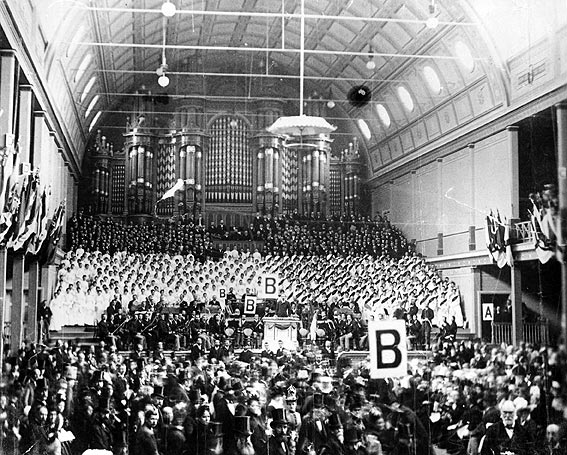
The organ in 1888
The following is a copy of the specification of the contract signed between the Commissioners and Mr Fincham:
GREAT ORGAN (Pressure 4 1/2 inches).
|
|
Pipes |
||||
|
1 2 3 4 5 6 7 8 9 10 11 12 13 14 15 16 17 18 |
Violon Double open Diapason Open Diapason Horn Diapason Clarabel Stop'd. Diapason Quint Flute Principal Gemshorn Twelfth Fifteenth Mixture 3 ranks Mixture 5 ranks Double Trumpet Posaune Trumpet Clarion |
16 16 8 8 8 8 6 4 4 4 3 2 16 8 8 4 |
61 61 61 61 61 61 61 61 61 61 61 61 183 305 61 61 61 61 |
CC to C |
wood metal metal metal wood wood wood wood metal metal metal metal metal metal metal metal metal metal |
|
|
1,464 | Total |
GRAND ORGAN (Pressure 10 1/2 inches)
|
Pipes |
|||||
| 1 2 3 4 5 6 7 |
Tuba mirabilis Tuba mirabilis Horn Diap Horn Diap Gemshorn Gemshorn Gemshorn |
8 4 8 4 8 4 2 |
61 61 61 61 61 61 61 |
CC to C |
metal metal metal metal wood metal metal |
|
472 |
Total |
SWELL ORGAN (Pressure 4 inches)
|
|
|
Pipes |
|||
|
1 2 3 4 5 6 7 8 9 10 11 12 13 14 15 |
Bourdon Open Diap Claribel Stop Diap Gamba Principal Gemshorn Suabe Flute Twelfth Fifteenth Mixture 5 ranks Double Trumpet Cornopean Oboe Clarion |
16 8 8 8 8 4 4 4 3 2 16 8 8 4 |
61 61 61 61 61 61 61 61 61 61 305 61 61 61 61 |
CC to C |
wood metal wood wood metal metal metal wood metal metal metal metal metal metal metal |
|
|
|
1,159 |
Total |
CHOIR ORGAN (Pressure 3-1/2 inches)
|
|
Pipes |
||||
| 1 2 3 4 5 6 7 8 9 |
Gedact Claribel Keraulophon Dulciana Harmonic Flute Dulcet Piccolo Glockenspiel 2 ranks Mixture 3 ranks |
16 8 8 8 4 4 2 |
61 61 61 61 61 61 61 122 183 |
CC to C |
wood metal metal metal metal metal wood metal metal |
|
|
732 |
Total |
SOLO ORGAN (Pressure 3-1/2 inches)
|
|
Pipes |
||||
| 1 2 3 4 5 6 7 |
Bassoon Clarionet Orchestral Oboe Vox Humana Oboe Clarion Clear Flute Vox Angelica |
16 8 8 8 4 4 8 |
49 61 61 61 61 61 110 |
C to C [TC] CC to C |
metal metal metal metal metal wood metal |
|
|
464 |
Total |
PEDAL ORGAN (Pressure 5 inches)
|
|
|
Pipes |
|||
|
1 2 3 4 5 6 7 8 9 10 11 12 13 14 |
Double open Diapason Double open Diapason Open Diapason light Open Diapason heavy Open Diapason Bourdon Quint Principal Violon Twelfth Fifteenth Mixture 3 ranks Trombone Clarion |
32 32 16 16 16 16 12 8 8 6 4 16 8 |
30 30 30 30 30 30 30 30 30 30 30 90 30 30 |
CC to C |
metal wood wood wood metal wood wood metal wood metal metal metal metal metal |
|
|
|
480 |
Total |
COUPLERS
Swell organ to great organ.
Choir (and solo) to great organ.
Grand organ to do.
Great organ to pedal do.
Swell to pedal organ.
Grand to pedal organ.
Choir (and solo) to pedal organ.
COMPOSITION PEDALS FOR COMBINATIONS
Four to great organ.
Three to swell organ.
Three to choir organ.
NO. OF STOPS
| Great organ Swell organ Choir organ Solo organ Grand organ Pedal organ -- Number of sounding stops Tremulant Couplers -- Total number of stops |
18 15 9 7 7 14 70 1 7 78 |
PIPES IN ORGAN
| Great organ Swell organ Choir organ Solo organ Grand organ Pedal organ --------- Total number of pipes |
1,464 1,159 732 464 427 480 4,726 |

Facade pipes in 1965 shortly before destruction of the casework
In conclusion, it is not out of place to mention that Mr Geo. Fincham first established himself in this colony upwards of 18 years ago, and came from the celebrated firm of James Bishop, Lisson Grove, London. During the time he has been here he has built and erected all the principal organs in the colony of Victoria, among which will be found those of St James' Anglican Cathedral; the Roman Catholic Cathedral of St Patrick, Melbourne; All Saints, St Kilda; St John's, West Melbourne; St Matthew's, Prahran; St George's, Malvern; St Jude's, Carlton; Masonic Hall, Melbourne; St John's, Camberwell; St Saviour's, Collingwood; the High Church, Geelong; Wesleyan Church, Geelong; Wesleyan Church, Chilwell; Wesley Church, Emerald Hill; St George's, Echuca; English Church, Inglewood; English Church, Dunolly; St Joseph's R.C., Dunedin; St Ignatius, Richmond, R.C.; St Mary's, Dandenong road, R.C.; The Church of England, Albury, N.S.W.; Memorial Church, Hobart; Wesley Church, Hobart; Wesleyan Church, Launceston; English Church, Warrnambool; and many others too numerous to mention."
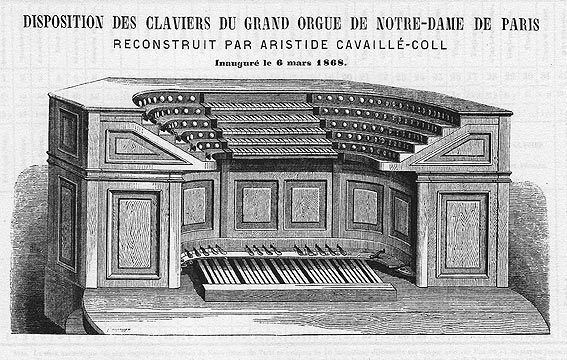
Console of the organ at Notre-Dame, Paris upon which the Exhibition organ console was modelled (from the 1868 official report)
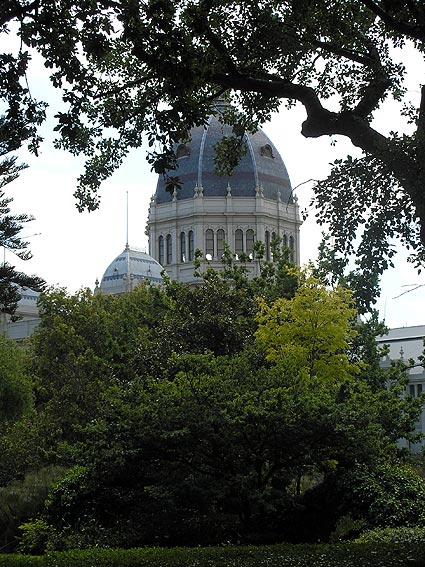
The National Trust of Australia - Victoria's citation of significance for the Royal Exhibition Building reads (in part):
The Exhibition Building was constructed in 1879-1880 for the 1880-1 Melbourne International Exhibition.International Exhibitions were associated with the boom in manufacturing and the development of a world economy during the nineteenth century. The exhibitions provided a means of displaying contemporary achievements in the arts and commerce as well as manufacturing. A competition to design the Melbourne Exhibition Buildings was held in 1878 and was won by Reed & Barnes, Melbourne’s most distinguished firm of architects at the time. The contract was awarded to prominent local builder David Mitchell (father of Dame Nellie Melba).
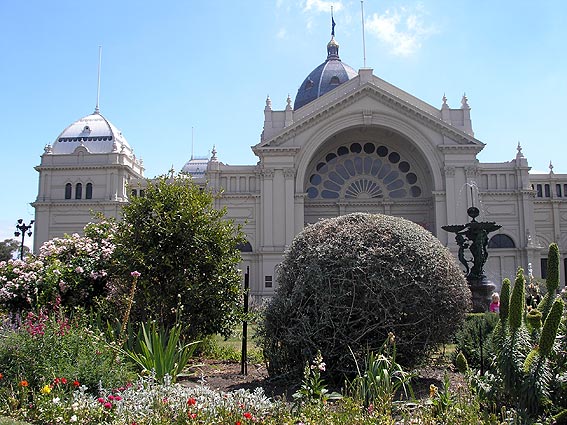
The existing building was at the centre of group of three permanent buildings, arranged in a U-shape, and a number of temporary annexes were located to the north. Joseph Reed also designed the landscaping for the entire gardens.The decorative scheme of the interiors was carried out by John Mather, notable as an outstanding easel painter and artistic decorator. The permanent buildings from the 1880 Exhibition were used for the 1888-9 Centennial International Exhibition, held to celebrate one hundred years of European settlement in Australia. New temporary annexes were built, and for the first time, an International Exhibition was lit by electricity. The main building was used in 1901 for the opening of the first Federal Parliament, for which the interior was redecorated by John Anderson. From 1901 to 1927 the 1880 western wing was used a temporary State Parliament while Federal Parliament occupied the Victorian Houses of Parliament.
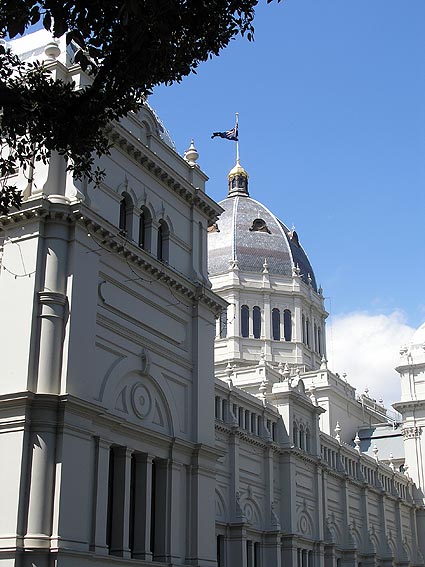
The Exhibition Building has continued to be used up to the present for a wide variety of purposes, including: for balls, concerts and fetes up to WWI; as an emergency hospital for influenza victims in 1919; by the RAAF during WWII; as a migrant reception centre after WWII; as a venue for the 1956 Olympic Games; as a motor registry and licence testing venue; for motor shows; and as a venue for school and university examinations. In July 2004 it became the first building in Australia to be added to the World Heritage List.
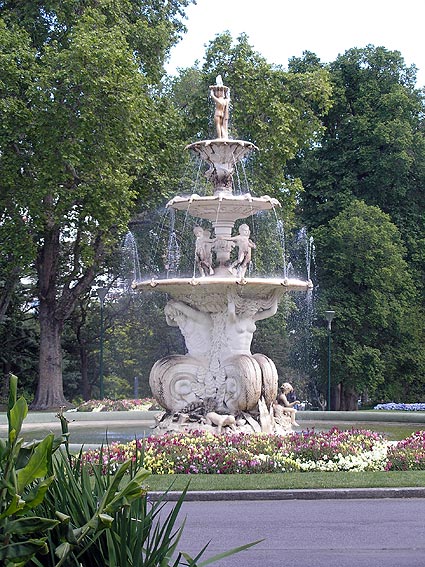
The ExhibitionBuilding is at the centre of the 26 ha Carlton Gardens, with the southern part containing the formally laid out garden which forms the forecourt to the building, while the northern section contains the Melbourne Museum and the park laid out after the completion of the 1888 Exhibition. The building is the major component of the permanent structures built for the 1880 Exhibition. The smaller wings at each end have been demolished. The building has a bluestone plinth and walls of rendered brick, now painted but originally a natural light coloured render. The timber framed roof is clad with a combination of corrugated galvanised steel and slate, embellished with decorative lead flashings and a cupola finished in gold leaf to the dome. Timber framed windows are incorporated into a clerestory within the roof space. Cast iron and rendered masonry are used to form the octagonal drum of the timber framed dome.
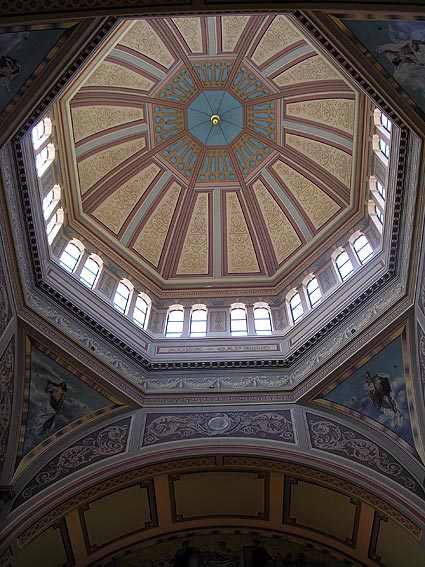
All windows and doors are timber framed and painted. The main hall is 152.4m long, 21.9m high and 48.8m wide, and the dome is 68m high and 18.3m in diameter. The interior is a large cruciform space with a central nave and wide two storey aisles. Timber is used extensively for the columns, balcony railings, ceiling lining and floor. The wall surfaces are plastered or ainted brickwork, except for the murals where a canvas base is used. All of the internal surfaces are painted in a complex scheme making extensive use of stencils. Murals also adorn the crossing at the lunettes, pendentives and in buttress panels under the dome. The basement contains offices, a museum related to the building, an archive and storage. [1]
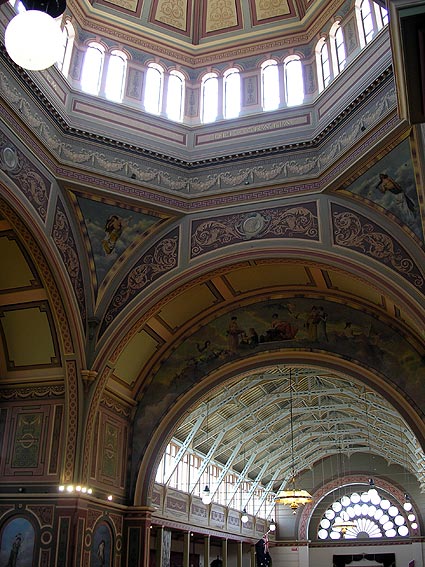
Photos: Simon Colvin (June 2007)
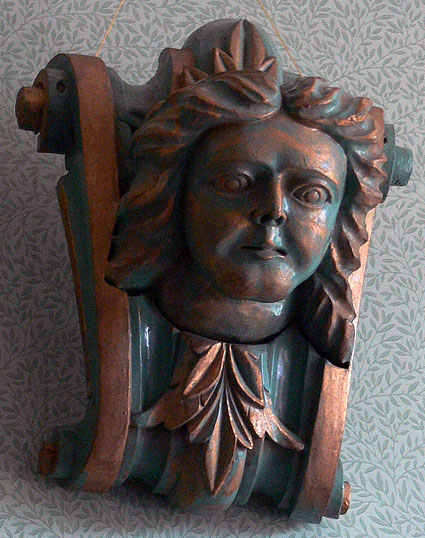
rescued by G.B. Fincham 1965 (in private ownership).
The original decoration has been overpainted. Photo: JRM
[1] National Trust of Australia - Victoria website: http://www.nattrust.com.au/trust_register/search_the_register/royal_exhibition_building